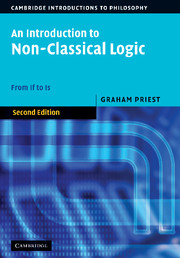Book contents
- Frontmatter
- Contents
- Preface to the First Edition
- Preface to the Second Edition
- Mathematical Prolegomenon
- Part I Propositional Logic
- 1 Classical Logic and the Material Conditional
- 2 Basic Modal Logic
- 3 Normal Modal Logics
- 4 Non-normal Modal Logics; Strict Conditionals
- 5 Conditional Logics
- 6 Intuitionist Logic
- 7 Many-valued Logics
- 8 First Degree Entailment
- 9 Logics with Gaps, Gluts and Worlds
- 10 Relevant Logics
- 11 Fuzzy Logics
- 11a Appendix: Many-valued Modal Logics
- Postscript: An Historical Perspective on Conditionals
- Part II Quantification and Identity
- Postscript: A Methodological Coda
- References
- Index of Names
- Index of Subjects
9 - Logics with Gaps, Gluts and Worlds
Published online by Cambridge University Press: 05 June 2012
- Frontmatter
- Contents
- Preface to the First Edition
- Preface to the Second Edition
- Mathematical Prolegomenon
- Part I Propositional Logic
- 1 Classical Logic and the Material Conditional
- 2 Basic Modal Logic
- 3 Normal Modal Logics
- 4 Non-normal Modal Logics; Strict Conditionals
- 5 Conditional Logics
- 6 Intuitionist Logic
- 7 Many-valued Logics
- 8 First Degree Entailment
- 9 Logics with Gaps, Gluts and Worlds
- 10 Relevant Logics
- 11 Fuzzy Logics
- 11a Appendix: Many-valued Modal Logics
- Postscript: An Historical Perspective on Conditionals
- Part II Quantification and Identity
- Postscript: A Methodological Coda
- References
- Index of Names
- Index of Subjects
Summary
Introduction
9.1.1 In this chapter, we will see how the techniques of modal logic and many-valued logic can be combined. More specifically, we will look at logics that add some kind of strict conditional with world semantics on top of a many-valued base-logic, specifically, FDE.
9.1.2 The non-normal worlds of chapter 4 will also make a reappearance, giving us some basic relevant logics. This will allow us to discuss further what, exactly, non-normal worlds are.
9.1.3 We will end the chapter with a brief look at so called logics of constructible negation, which have close connections with intuitionist logic; and an even briefer look at connexive logics.
Adding →
9.2.1 FDE has no conditional operator. The material conditional, A ⊃ B, does not even satisfy modus ponens, as we saw in 8.6.5. In any case, as we have seen, using possible-world semantics provides a much more promising approach to the logic of conditional operators. Thus, an obvious thing to do is to build a possible-world semantics on top of the relational semantics of FDE.
9.2.2 To effect this, let us add a new binary connective, →, to the language of FDE to represent the conditional. By analogy with Kν, a relational interpretation for such a language is a pair 〈W, ρ〉, where W is a set of worlds, and for every w ∈ W, ρw is a relation between propositional parameters and the values 1 and 0.
- Type
- Chapter
- Information
- An Introduction to Non-Classical LogicFrom If to Is, pp. 163 - 187Publisher: Cambridge University PressPrint publication year: 2008



